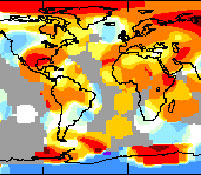In 2007, the U.N. Intergovernmental Panel on Climate Change (IPCC) produced its fourth report, delivering the latest consensus views of the world scientific community on global climate change. The voluminous document was summarized in “Climate Change 2007: A Synthesis Report” (PDF). A new, fifth IPCC report is expected to be published between 2013 and 2014 (see this 2011 IPCC update.) Much peer-reviewed scholarly research continues to emerge, but the 2007 report still stands as the definitive policy document expressing the world’s scientific consensus.
The report presents uncertainty on issues in a mathematical way. Numerical ranges given in square brackets in the report indicate that there is an “estimated 5% likelihood that the value could be above the range given in square brackets and 5% likelihood that the value could be below that range.”
The report begins by stating that “warming of the climate system is unequivocal,” and it presents the following data relating to temperature rise: “Eleven of the last twelve years (1995-2006) rank among the twelve warmest years in the instrumental record of global surface temperature (since 1850). The 100-year linear trend (1906-2005) of 0.74 [0.56 to 0.92]°C is larger than the corresponding trend of 0.6 [0.4 to 0.8]°C (1901-2000) given in the [IPCC’s Third Assessment Report of 2001]. The linear warming trend over the 50 years from 1956 to 2005 (0.13 [0.10 to 0.16]°C per decade) is nearly twice that for the 100 years from 1906 to 2005.” (For an interim look at temperatures through 2010, see NASA’s GISS Surface Temperature Analysis.)
The report also states at the outset findings relating to sea level rise: “Increases in sea level are consistent with warming. Global average sea level rose at an average rate of 1.8 [1.3 to 2.3] mm per year over 1961 to 2003 and at an average rate of about 3.1 [2.4 to 3.8] mm per year from 1993 to 2003. Whether this faster rate for 1993 to 2003 reflects decadal variation or an increase in the longer term trend is unclear. Since 1993 thermal expansion of the oceans has contributed about 57% of the sum of the estimated individual contributions to the sea level rise, with decreases in glaciers and ice caps contributing about 28% and losses from the polar ice sheets contributing the remainder.”
Other key points include:
- “Of the more than 29,000 observational data series, from 75 studies, that show significant change in many physical and biological systems, more than 89% are consistent with the direction of change expected as a response to warming.”
- “Annual emissions [of CO2] have grown between 1970 and 2004 by about 80%, from 21 to 38 gigatonnes, and represented 77% of total anthropogenic GHG emissions in 2004.” Additionally, “most of the observed increase in global average temperatures since the mid-20th century is very likely due to the observed increase in anthropogenic GHG [greenhouse gas] concentrations.”
- “Based on a range of models, it is likely that future tropical cyclones…will become more intense … associated with ongoing increases of tropical sea-surface temperatures.” Moreover, by the 2080s “many millions more people than today are projected to experience floods every year due to sea level rise.”
- In terms of agreement on mitigation strategies the working group found that “…successful [international] agreements are environmentally effective, cost-effective, incorporate distributional considerations and equity, and are institutionally feasible.”
- “There is high confidence that neither adaptation nor mitigation alone can avoid all climate change impacts” given that “unmitigated climate change would, in the long term, be likely to exceed the capacity of natural, managed and human systems to adapt.”
Tags: carbon, greenhouse gases, global warming, campaign issue


Expert Commentary